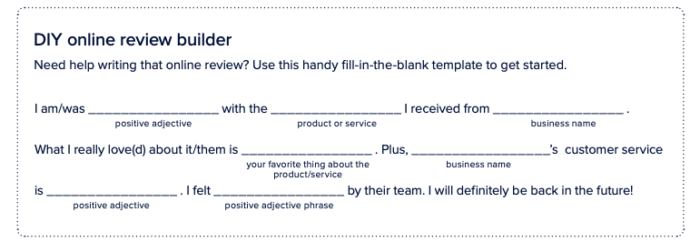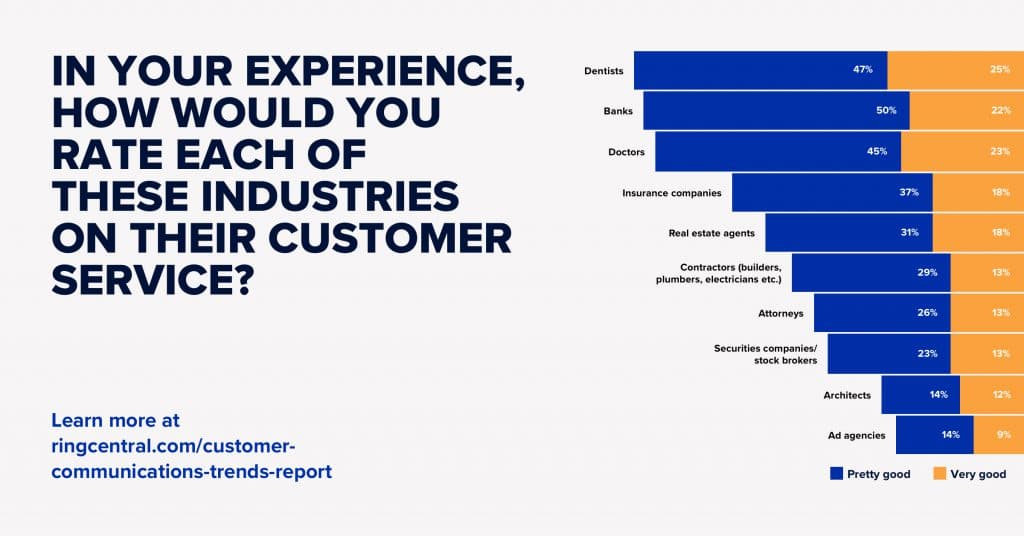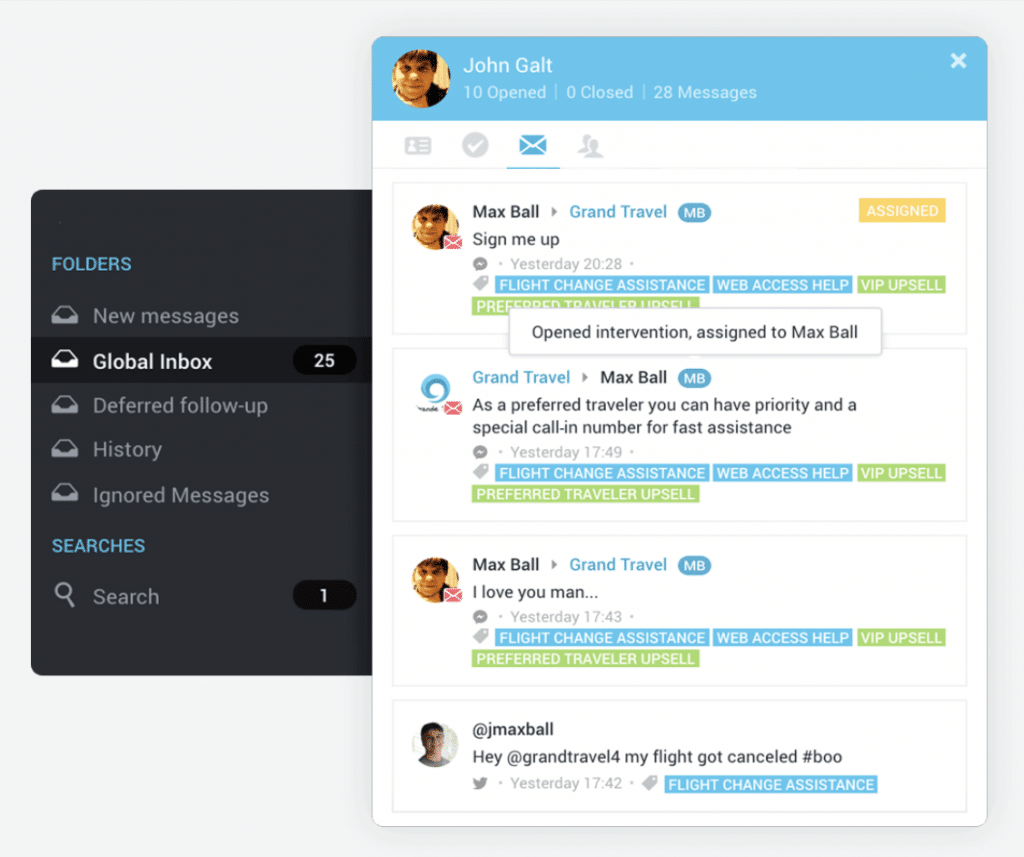When it comes to making decisions, we humans aren’t always independent thinkers. From buying our morning coffee to big-ticket items like a new car, we depend on our network’s opinions, advice, or perspectives for making the right decision.
With the internet, those networks get way, way bigger. We’re no longer confined to just friends, family, and coworkers—we can see what people all around the world think with just a quick Google search.
And these customer reviews hold serious weight with shoppers. Online reviews—either positive or negative—can impact over 93% of consumers’ decisions.1
While reviews can accumulate on their own, they shouldn’t exist in a vacuum. Knowing how to ask for reviews, leverage them to get more business, and respond to less-than-favorable customer testimonials can improve your business image and land you more long-lasting customers.
Keep reading to learn about:
- Why customer reviews are so important
- 9 types of reviews and how to get more of them
- How to respond to positive and negative customer reviews
🌟 🌟 🌟 🌟 🌟 Want to get more customer reviews for your business? Use these outreach templates (and DIY customer review builder!) to help your customers give you the best review possible.
Why are customer reviews so important?
Customer reviews build something known as social proof, a phenomenon that states people are influenced by those around them. This might include friends and family, industry experts and influencers, or even internet strangers.
Social proof can push customers who are on the fence about buying a product to make a purchase (or consider other alternatives). While there are many different forms of social proof (like influencer campaigns and company partnerships), customer reviews have a special place in shoppers’ hearts.
Think about the last time you tried a new restaurant. Or bought a vacuum. You probably looked for reviews online first, right? When considering a purchase, people want first-hand perspectives from other people just like them. While a famous influencer might catch their attention, experiences from peers are also important if you want to convince them to buy.
Depending on the industry your business is in, customer reviews might be especially important because they help offset a generally negative view of certain industries. For example, if you work in advertising, you’ve got a bit of an uphill battle—only 23% of respondents surveyed in the Customer Communications Review said that ad agencies provided “very good” or “pretty good” service, and ad agencies rank dead last in comparison to other major industries:
9 customer review examples (and how to get more reviews)
Customer reviews come in many different forms. Including a few good ones on your website can improve your chances of winning more customers—who doesn’t want that?
And anything you can do to make it as easy for your happy customers to write those reviews for you will help. For example, here’s a handy Mad-Libs-style customer review builder that you can attach to your message or email to the customer when you’re asking if they can write a review or testimonial for you:

You can download this customer review template, along with examples of outreach communications, to help you save a ton of time as you’re gathering customer reviews 👇
Let’s walk through the different kinds of customer reviews, starting with the easiest ones to collect.
1. Quotes
Testimonials or quotes from your customers are one of the most common forms of customer reviews. You’re most likely to find them on a company website, typically on the homepage, or in their marketing materials.
Here’s an example of a quote testimonial from WordPress:

These short (typically only one to two sentence) overviews of how your product or service impacted a company helps give your brand credibility. With quote testimonials, those impressive claims you’re making actually sound believable because they’re backed up by someone who’s, well, not you.
We list customer quotes as the easiest type of review to get because they involve very little effort for you and your customer. Because you’re in control of adding them to your website, all you need to do is ask your customers to share their experience in an email, in person, or over the phone.
Quotes also allow you to choose the great customer service stories, perspectives, or opinions that you think are most valuable. You can highlight your high-profile clients—and who says you have to use the less-than-favorable reviews?
How to get a quote review:
Ask for it. Call up your long-term customers and ask if they’d be willing to share a testimonial or a bit about their experience working with you to display on your website.
Or look for positive words of encouragement in email and social media responses or everyday conversations. If a customer gives you a great quote, ask if you can showcase it on your website.
You might be on multiple social media platforms, so how can you keep track of all these messages? If you’re providing omnichannel customer service, you might already be using a tool that can consolidate all your customer conversations and communication channels into one handy dashboard. Like this:
To get awesome customer reviews, you need to provide awesome customer service, whether that’s by focusing on proactive or agile customer service.
2. Peer review sites
Peer review sites are probably what you think of when you think of customer reviews. These include Google reviews, Facebook reviews, Yelp, Amazon, or G2 Crowd (if you’re a software company).
You’ve probably encountered these kinds of reviews while you were deciding whether or not to try a local business for the first time:

Reviews on peer-to-peer sites can happen organically, often removing the company from the review process entirely. (This can be a nightmare if you’re managing a small business, since one bad review can have a huge impact, but this also makes the reviews seem more authentic.) Customers don’t need to worry about if companies have edited them to be more favorable (or deleted reviews they didn’t agree with).
However, this also means you’re not as in control of these kinds of reviews.
But that doesn’t mean you can’t do anything at all. These peer-to-peer review sites are often one of the first places a potential customer looks when considering a purchase, so ensuring you have some positive reviews on each is important.
How to get a review on a peer review site:
Again, the best way to do this is to ask. Send an email, ask in person, or add links to your website that make it easy for customers to leave their opinion.
3. Social media
Social media is becoming just as much a resource for businesses that want to build brand awareness as it is for people who are interested in connecting with brands. But don’t just your social media campaigns to get prospects. Not only are customers turning to social media to ask brands questions or learn about their services, they’re also using their accounts to share opinions and reviews.
Here’s an example from American Eagle’s spin-off clothing line Aerie:

Like peer-to-peer review sites, the company usually isn’t involved in the review process—making them feel more transparent and honest. But one of the biggest benefits of having reviews on social networks is that prospective customers can get a feel for who the customer is in ways they can’t with testimonials or peer-to-peer review sites.
How to get social media reviews:
Encourage customer reviews on social media by creating communities where customers are empowered to share their experiences or purchases. For example, Aerie uses the hashtag #AerieReal to make it easy to see how customers are styling their items in real life:

Create a unique hashtag to compile your customer reviews in one place.
4. Case studies
Case studies dive deep into customer results and are particularly useful for businesses selling to businesses (aka the B2B space).
Here’s an example of a case study from RingCentral and our client Box:

Case studies—unlike traditional customer reviews—are written from the perspective of the company doing the work or providing the product. Rather than the customer explaining how they helped, the company walks through what they did to help their customer reach their goals.
This perspective gives potential customers an idea of how your team works. It gives you a chance to show off your problem-solving skills and attention to detail, and it allows your potential customer to envision how you might help them.
How to get case study reviews:
Write your own! Be sure to mix in quotes, results, and info from your customer to back up your claims. Each case study should read like a partnership—not just a one-sided perspective.
5. Customer stories and interviews
We all love a good story—and that’s probably clear in the review types that we’ve listed so far. Customers want to see themselves in the people your company has already helped; they want to know what your customer experience is like. One way to do this is through customer stories and interviews.
Squarespace is one company that does this well:

Through stories and interviews, Squarespace shares who their customers are, what the vision or mission of their website is, and how Squarespace provides them with the platform to reach those goals.
For Squarespace, they get an opportunity to showcase how diverse their client pool is. But it gives customers an opportunity to connect with each other too. Similar to case studies, stories and interviews paint a larger picture of what the customer is hoping to accomplish—only you have to be less self-centered here and make sure your customer is the star of the story.
How to get customer story-style reviews:
Stories and interviews give a more personal perspective. Instead of hearing from your company, they’re hearing stories straight from the customer. So, to get those stories, send customers a questionnaire or old in-person interviews.
Give your customers an opportunity to share their stories, then focus on filling in the rest of the narrative with images, videos, and other content.
💡 Get more positive customer reviews with these free outreach templates (and DIY customer review builder).
6. Blog posts
Blog post reviews give your potential customer an opportunity to really dig in deep into your product or service, and even your brand and culture as a company. Rather than just a sentence or two like a customer might find on your website or a few hundred words displayed on a peer-to-peer review page, blog posts can be thousands of words, complete with step-by-step instructions with images that thoroughly explain a process or perspective.
This is a great example of a blog post review on Warby Parker:

These kinds of reviews can typically answer more complicated questions that require more space and time—something that isn’t really possible with traditional reviews.
But one of the biggest benefits of blog post reviews is the SEO value, meaning you can get these pages to show up on Google when people are searching for reviews of your business. If you’ve ever searched for “[product] review,” you’ve probably encountered a post like this before. Because these posts tend to be descriptive, long-form, and useful, they can rank pretty highly.
How to get blog post reviews:
Getting reviews like this one can be a little difficult. After all, not everyone has a blog to write on. You can increase your chances by offering a free sample or trial of your products or other goodies to industry influencers and experts who run popular blogs.
7. Videos
Consumers like videos. This isn’t anything new. In fact, 85% of internet users in the United States say they watch video content—making it a strong contender as an outlet for your customer reviews2.
Shopify is one example of a company using video testimonials:

Video reviews can give potential buyers something most written reviews can’t: emotion.
Viewers can see the difference your products or services have made. They can build a stronger connection with your customers, making it easier to put themselves in their shoes. These deeper connections can spark more sales.
Creating videos doesn’t need to be complicated. Customers sharing selfie-style videos talking about what your product has done, or just stationed in front of a camera, can get the same message across.
While you want the image and audio to be clear in the videos you share, the quality of the message is more important. If you have a customer willing to discuss on camera how you’ve helped them, this can go a long way.
Here’s another video review of Shopify, this time from YouTube:
This one doesn’t involve a lot of money or production—just a user sitting in front of his computer camera giving his opinion of the tool. And it still has over 15,000 views.
How to get more video reviews:
If you have the budget for larger production projects you want to feature on your website (like our first example), reach out to the customers you think have the best story or video presence. If you’re spending the money, you’re in control of the story.
However, to get more reviews like the second, treat it the same as blog post reviews. Reach out to industry experts who have large YouTube followings and offer free trials or discounted products in exchange for an honest review.
8. User-generated content
User-generated content includes social media posts, videos, images, audio, or other kinds of content created by—you guessed it—a user of your products or services. Some of the review types we’ve already covered would fall into this category (like social media posts or customer videos).
But user-generated content isn’t just an online review or a customer sharing an image with your hashtag. That’s just the start. You then need to take that content and use it in a bigger, coordinated way.
Here’s an example of how direct-to-consumer mattress brand Casper does it:

Like the Aerie example, Casper encourages users to share pictures using their products (in this case, sleeping on their mattresses) on social media. When someone tags Casper in their post, the image is added to a reel on their website.
They also share customer posts on their own Instagram feed:

Dogs and babies do well on Instagram, haven’t you heard?
User-generated content puts your customers’ experiences front and center. Although they’re not exactly traditional reviews, prospective customers can see how happy others are with your products. It helps build authenticity—something millennials love.
How to get more user-generated content:
This one follows the same tips as social media reviews. Encourage your audience to share their experiences by creating a unique hashtag or tell them to tag you in their posts.
Then start commenting, sharing, and engaging with your own audience. When your audience sees you showcasing other users’ experiences or getting into conversations, they’ll jump to get involved.
9. Brand ambassadors
Think of brand ambassadors as an external sales team. They’re loyal customers who love your brand or product so much they’re willing to recommend your products or services to their own networks. The bonus with having brand ambassadors is that they’re usually seriously obsessed fans—and are probably more familiar with your product than even your own team.
Brand ambassadors don’t need to have large followings. In fact, anyone can be a brand ambassador. You probably have brand ambassadors without even knowing it.
One of the best examples of brand ambassadors online is for the budgeting software, You Need a Budget (YNAB). Users are active on platforms like Reddit, sharing advice on how the platform has changed their life for the better:

How to get more brand ambassadors:
While you could pay for brand ambassadors, you’re better off creating them organically. In YNAB’s case, they did so by providing a unique spin to traditional budgeting software. By helping customers who otherwise would have slipped through the cracks, they’ve created a loyal fan base.
It takes more time to build brand ambassadors naturally, but this is a high-reward review since their advocacy will be much, much stronger, directed, and in-depth than your average Yelp review.
👀 How can you get more customer reviews? Start with these free outreach templates (and DIY customer review builder).
How to respond to customer reviews
We’ve said it before and we’ll say it again—your customer reviews shouldn’t exist in a vacuum.
If you’re just allowing customers to leave reviews on peer-to-peer pages, social media, or their own blogs without acknowledging them or responding to them, you’re not making use of powerful content that has been known to convert leads.
But your response process should look different depending on if the review is positive or not.
How to respond to a positive review
Congrats! A customer left you a positive review. Time to pop the champagne—and write a response.
Responding to a positive review is a lot less stressful than responding to something negative but just as important. Letting your happy customers know you’ve seen their kind words and you appreciate their feedback can encourage them to continue singing your praises.
Here’s how to respond to positive reviews:
- Make your message personalized. Customers will quickly realize if you’re just copying and pasting messages to all your reviews. Instead of giving a generic “Thanks!” take the time to write a thought-out, personalized message.
- Respond in a day or two. Fast responses show you’re paying attention. While you’re not expected to drop everything to respond to reviews, a quick response—especially on social media—can keep customers engaged with your brand. Reduce your response time by integrating your social media apps with your cloud-based communications system. RingCentral connects with top social platforms, like Instagram, Facebook, and Twitter, so you can easily respond without needing to switch platforms.
- Show your personality. This is your chance to engage directly with a happy customer, so make the most of it. Respond with some personality—humor, kindness, wit, you get the idea—to really connect with your customer. Regardless of your brand’s personality, be authentic. Your audience will be able to tell if you’re not.
- Give a recommendation. Now is a great time to point your customer in the direction of another product, a piece of content, or something related to their review. (This is a great way to personalize your response!) For example, if they say they enjoyed a product, recommend they look into a supplementary project, or suggest they check out a blog post that tells them how to make the most of their purchase. Your main goal is to keep them engaged!
- Ask if you can showcase their review. If someone leaves you a particularly stellar or unique testimonial, ask for permission to share it! Display it on your website, show it off on social media, or create user-generated content out of it. Showing off the kind words of your happy customers is more powerful than just telling people how awesome you are.
How to respond to a negative review
Negative reviews are much less exciting than positive reviews. They can be stressful, and responding can feel like a lost cause. But even the most unhappy customer can change their opinion with the right encouragement.
Responding to a negative review is a little less “just be yourself” and a little more strategic:
- Respond promptly. Again, you may not need to drop everything you’re doing to respond, but it’s more important to get to negative reviews quickly than positive reviews. If a negative review is posted for too long without a response, not only is it frustrating for the unhappy customer, but it can also leave a bad taste in prospective customers’ mouths. Do your best to get to negative responses in just a few hours.
- Put the customer first. You may not agree with what the customer is saying, but that doesn’t mean you should be on the defensive. Instead, listen and see where the customer is coming from—you have to identify where their frustration lies. Think about the response you would want in their shoes and try and find a solution.
- Respond publicly, but push the conversation to a private channel. You don’t want to get into a debate with an unhappy customer on Yelp, but you also don’t want it to seem like you’re not acknowledging negative reviews. Reply to unhappy customers on the platform they’ve left the review on, but encourage them to continue the conversation through a private message on social media, email, or phone call.
If you have a phone or communications tool, it can make this part easier. For example, RingCentral integrates with other popular social media apps to let you switch between platforms while keeping the integrity of your conversations:
(When frustrated customers don’t have to repeat their issues over and over, it might help soothe them a bit and give you a better shot at turning the interaction around.)
- Follow through. Don’t just apologize and call it settled. In order to change your customer’s opinion, you need to find a solution to their problem and follow through on it. Work with the customer to discover what will change their opinion—and follow up after to see if you’ve been successful.
- Don’t get it taken down. It can be tempting to get a negative review removed, but it can hurt the trust you’ve built with other customers—especially if that unhappy customer realizes they’ve been silenced. If you respond the right way, leaving the review up also proves to prospective customers that you care about your customers’ opinions.Sometimes, an unhappy customer will even write a positive follow-up review to show people that you actually turned things around for them:

Replying to reviews (both positive and negative) appropriately means having open communication with your customers. Bringing reviews in as part of your customer feedback cycle can help you identify communication gaps or other areas where you’re not meeting expectations.
What can you learn from these customer review examples?
Asking your audience to buy from you without any reinforcement from other customers is an uphill battle. Without any reviews or social proof, you’re expecting them to invest solely on blind trust—and it doesn’t work well.
Rather than making your job more difficult, make the most of the happy experiences your customers choose to share. From peer-to-peer pages to your own website and social media accounts, showcasing positive reviews—and responding to negative reviews the right way—can help you land more customers.
1thedrum.com/news/2017/03/27/online-reviews-impact-purchasing-decisions-over-93-consumers-report-suggests
2statista.com/statistics/272835/share-of-internet-users-who-watch-online-videos
Originally published Feb 19, 2020, updated Jan 29, 2023







